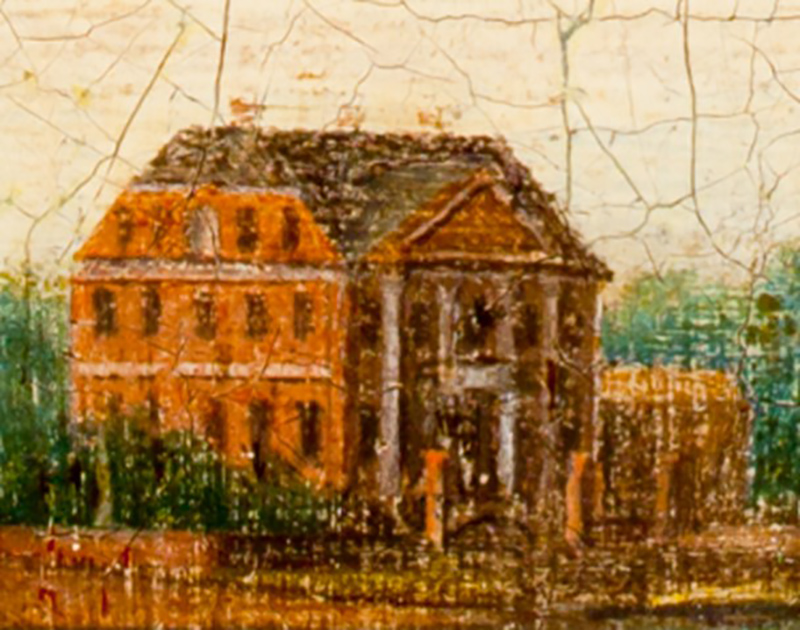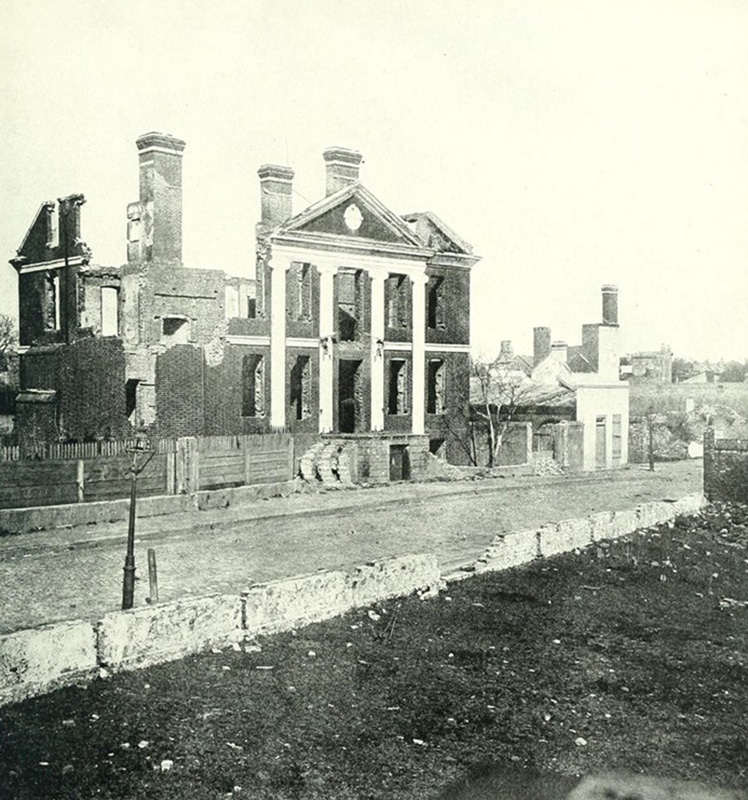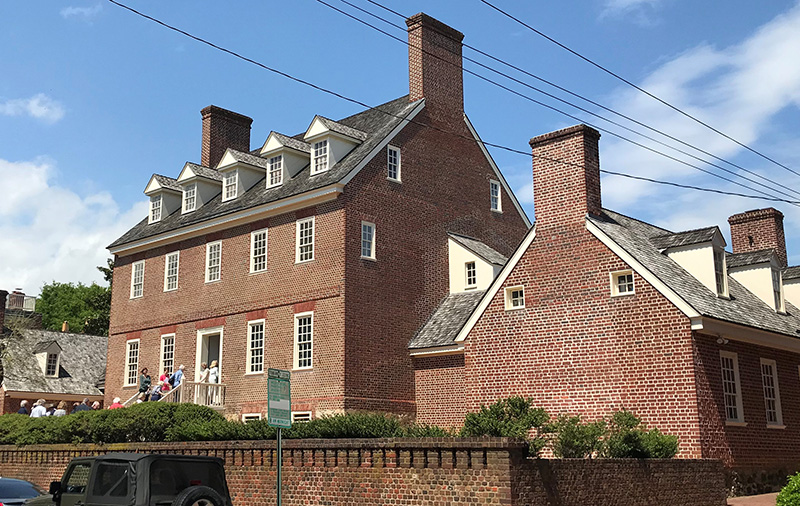The Contributions of Enslaved Artisans in Annapolis and Charleston: New Research and Resources
by Bethany J. McGlyn and Tiffany Momon, PhD
In September, the Decorative Arts Trust invited us to speak about our work on enslaved craftspeople and the decorative arts during a Trust Talk titled Who Built the City on the Severn? Slavery and Craft in Early Annapolis. We discussed how enslaved artisans contributed to the production of objects like clocks, silver, and furniture, and how evidence of their work is found in advertisements, account books, and on material goods themselves. This article highlights two case studies, the Charles Pinckney Mansion in Charleston, SC, and the James Brice House in Annapolis, MD, with a focus on the enslaved craftspeople who built them.
A search through the Pinckney family manuscripts, not for architectural details about the Pinckney Mansion but for enslaved laborers associated with the mansion’s construction, uncovered a host of significant information. The search revealed several enslaved men that Pinckney hired from other enslavers, including Stratford, London, and others referred to by number and race such as “two other negroes” or referred to as their enslaver’s property such as “Savage’s Negro.”1 Among these enslaved craftsmen was Pompey, a carpenter and apprentice to John “Quash” Williams, the well-known Black master carpenter responsible for the Pinckney Mansion’s construction. What we can determine about Pompey’s early life is that he was enslaved by British Army Officer George Lucas, Eliza Lucas Pinckney’s father, on his Garden Hill Plantation outside of Charleston. Pompey later became the property of Charles Pinckney and Eliza Lucas Pinckney through their 1744 marriage settlement.2
In 1745 and 1746, George Lucas included Pompey in lists of enslaved individuals owned by the Lucas and Pinckney families.3 Often described as “Pompey the Carpenter,” Pompey labored on various Lucas and Pinckney family plantations in South Carolina. In 1745, William Murray, an overseer for the Pinckney family, wrote to Charles Pinckney describing events at the plantation and noted, “Pompey has been very bad twise [sic] with the Plursey & I could not get the New barn finished.”4 Pompey returned to the documentary record in 1750 through his work on the Pinckney Mansion (figure 1), with Pinckney and John Williams noting that he completed various carpentry and joinery related tasks.5 In February 1753, Charles Pinckney hired Pompey and several other enslaved craftspeople for the combined annual sum of £60.6 What Pompey’s brief story illustrates is that, although the history of the Pinckney Mansion is well known, including its destruction in the great Charleston fire of 1861 (figure 2), much less is known about the enslaved craftspeople who made the home’s existence possible. Pompey and the 20 other known enslaved individuals associated with the construction of the Pinckney Mansion are worthy of further research and recognition for their contributions to one of Charleston’s finest colonial homes.
Account books left by Annapolis lawyer, politician, and enslaver James Brice reveal details similar to those in the Pinckney Papers. In January of 1766, Brice forcibly relocated several enslaved laborers from his Eastern Shore plantation to Annapolis, where they would begin the process of “Digging Foundation House 49 by 44, 6 feet Deep.”7 For four months the enslaved men dug on lot 97, inherited by Brice “for the Purpose of Building a dwelling House,” from his father one year prior.8 By mid-April, Brice transported four additional enslaved to Annapolis to assist stonemason John Scorce, who earned almost £50 for “raising the Cellar Story of Building” while those who labored alongside him received no payment.9
Today, Brice’s imposing home dominates East Street and was the location of a tour during the Trust’s spring 2019 symposium in Annapolis (figure 3). At its completion in 1774, the house would have been among the tallest buildings in town, with commanding views of the harbor from the front and the Severn River from the back. The brick house features a two-and-a-half story central block flanked on either side by two one-and-a-half story wings, each connected by an enclosed hyphen. Although calling back to the five-part Palladian country houses of England, Brice’s house is a vernacular building with a steeply pitched roof and large brick chimneys on each gable end, architectural features common in the early Chesapeake. Relying on his own visual and spatial vocabulary and aided by design books like Palladio’s Four Books of Architecture, Brice assumed the role of gentleman-architect. His careful records of expenses, materials, and labor span the entirety of the eight-year project and provide unique detail into the daily lives and work of a diverse group of highly-skilled craftspeople, bound and free.10
James Brice’s house has long been celebrated as an icon of colonial American architecture and interiors (figure 4), but his account books give us the opportunity to piece together the contributions of enslaved artisans. In October 1767, Brice paid nearly £9 to “William Reid for the hire of his Negro Sawyer.” Brice purchased shoes for the sawyer in July, and another pair the next October—a small but significant detail indicating long days of strenuous, messy, and likely dangerous labor. Brice also recorded payments to Charles Wallace for the expertise of an enslaved man named Watt Wright from 1767–1768. We know little else about William Reid, Watt Wright, and the other enslaved artisans mentioned in Brice’s accounts, but their lives and work are central to Annapolis’s material history.11
What these examples reveal is that throughout the 18th century free and enslaved Black craftspeople contributed to the construction of some of this country’s finest architectural masterpieces. Regrettably, the research often stops there, but the lived experiences of these craftspeople, the communities they formed with each other, and the ways in which they shaped our field are deserving of more investigation. The brief stories presented here are but two examples of how the framing of our inquiries and the direction of our research can shed new light on well-known objects.
1 Charles Pinckney, “The Pinckney Papers,” March 30, 1747, The Pinckney Papers, The South Caroliniana Library at the University of South Carolina.
2 Eliza Lucas Pinckney, “Eliza Lucas Pinckney, Marriage Settlement, May 1744,” May 1, 1744, The Papers of Eliza Lucas Pinckney and Harriott Pinckney Horry Digital Edition, The University of Virginia Press (hereafter Pinckney-Horry Digital Edition, UVA).
3 George Lucas, “List of Slaves, George Lucas, May 1745,” Text, Pinckney-Horry Digital Edition, UVA.
4 William Murray, “William Murray to Charles Pinckney,” October 30, 1745, Pinckney-Horry Digital Edition, UVA.
5 John Williams, “Account of Charles and Pompeys Time They Worked for Me,” July 4, 1751, Charles Pinckney Papers (1699 – 1758), The South Caroliniana Library at the University of South Carolina.
6 Charles Pinckney, “Charles Pinckney, (1699–1758), Rent Roll, 24 January 1753,” Pinckney-Horry Digital Edition, UVA.
7 James Brice Account Books, in Orlando Ridout IV, Building the James Brice House 1767–1774 (Annapolis: Friends of the Maryland State Archives, January 2013), 27.
8 Will of Judge John Brice, 1766. Prerogative Court (Wills), MSA S538-50, 34:243, Maryland State Archives, Annapolis, MD.
9 James Brice Account Books, in Orlando Ridout IV, Building the James Brice House 1767–1774 (Annapolis: Friends of the Maryland State Archives, January 2013), 27, 28.
10 Orlando Ridout IV, Building the James Brice House 1767–1774 (Annapolis: Friends of the Maryland State Archives, January 2013), 8-11.
11 James Brice Account Books, in Orlando Ridout IV, Building the James Brice House 1767–1774 (Annapolis: Friends of the Maryland State Archives, January 2013), 64, 74, 83 and 99.
Bethany J. McGlyn is the Sewell C. Biggs Curatorial Fellow at Winterthur Museum. Tiffany Momon, PhD, is a Visiting Assistant Professor at Sewanee, The University of the South and is founder of the Black Craftspeople Digital Archive.
A print version of this article was published in The Magazine of the Decorative Arts Trust, one of our most popular member benefits. Join today!




